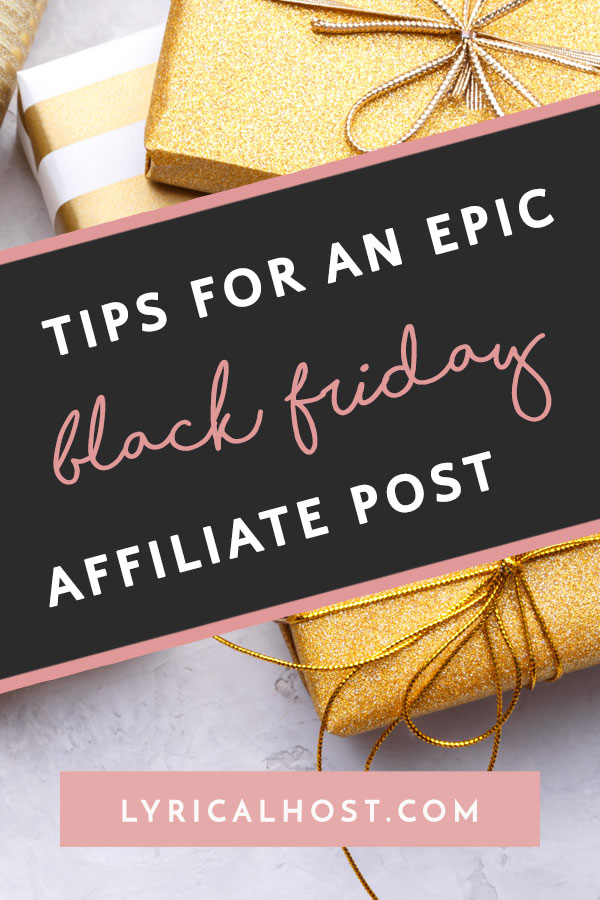Black Friday and Cyber Monday are a great time to earn affiliate commission. People are in the mood for buying – especially from the warmth, quiet and comfort of their own home! – so you don’t need to push for a sale. The most important thing is to create an appealing buying guide and market it well to get ahead of the competition.
This post takes you through planning, creating and promoting a Black Friday buying guide for any niche…whether you already have an audience or not!
Currently reading: The Blogger's Guide To Creating A Great Black Friday Affiliate Post Click To Tweet
Planning your Black Friday affiliate post
Brainstorm a list of companies to include based on 1) who you’re already an affiliate for; 2) brands you love but don’t work with yet; 3) other websites you can think of that are likely to be running deals that will be a good fit.
A lot of people will be promoting the same few companies, so you can make your guide more unique by reaching out to smaller companies, for example small WordPress plugin creators, your favorite Etsy sellers, and so on. These are also likely to be companies that genuinely value your support and want to build a personal relationship with you, so the advantages stack up!
If you’re finding it difficult to think of many companies, utilize #PRRequest #BloggerRequest and #JournoRequest hashtags on Twitter to shout out requests for your specific niche.
Make sure you’re clear on who your blog post is aimed at, and resist the temptation to throw a bunch of random links in just because you’re an affiliate. For example, if your post is aimed at parents, you’ll likely want to stick to baby- and child-related deals rather than including links to your favorite image editing tools or social media schedulers (even if many of those parents visiting your blog are also likely to be bloggers).
The next step is to email/tweet/message the companies on your list asking what deals they’re planning because you’d love to include them in a roundup. Companies typically love this and welcome these requests, so don’t worry about reaching out! If you’re planning to contact a lot of companies, speed the process up by creating an email template or BCCi’ng your email. Once they reply, you could even ask them to fill out a short form with information about their deal, a copy snippet, and an image, to save you time.
If you get a lot of traffic to your website and you’re planning to promote your post heavily, you could even put together a quick one or two page PDF to offer paid spots to companies. This could get them perks like being promoted to the top of your list, having their mention in your post highlighted in some way (for example bigger, in a different color, in a box), devoting a certain number of words to them in your post, social media posts just mentioning them, a prominent mention in your email, etc.
Creating your blog post
Before you start, make sure your content will fall in line with each affiliate program’s rules, you have an appropriate disclaimer for affiliate links, and you know how to mark your links as nofollow or sponsored.
Crafting the perfect post title can be a real challenge for these types of posts. Ideally you want to think of a hook that will appeal specifically to your niche and entice people to click whether they’re in their inbox, a Facebook group, search results, or on social media. For this reason, unless you’re only planning to promote your post in one or two places, avoid platform- or channel-specific quirks and conventions.
Instead, focus on creating a title that appeals to humans by including an adjective and a benefit. For example, “The Best Black Friday Deals For Eco-Conscious Travel Bloggers [2019]” will help you attract people more interested in the content than the more generic “Black Friday Buys For Bloggers.” If you’re appealing to a large group, narrow it down by focusing on the benefits. E.g. if you’re targeting parents, “10 Handpicked Black Friday Deals For Frazzled Parents,” “5 No-Brainer Black Friday Deals For Homeschoolers,” or similar. Titles that highlight pricing and savings are also likely to do well as people are very cost-driven around this sale. “Stress-free,” “hassle-free” and “time-saving” are also strong concepts to incorporate as they’re universally desirable and people are typically more stressed and have less time over the holidays.
As Black Friday blog posts are super competitive, making the title specific to your niche can be a way to incorporate less competitive keywords for search engines. However, you may not want to concentrate on SEO too heavily for this kind of post in the first year you publish it as you’re likely to struggle with ranking it well in such a short space of time, and this type of post has a very short lifespan (although it will reward you year on year when you get it going!). If you’re planning to edit your post to use next year, be sure to avoid dates and numbers in your URLs so they stay fresh. Your “10 best” may be “20 best” next year!
Create a skeleton outline for your post content to build your post faster and more consistently. To do this, divide your chosen affiliate links into groups. Then title each group and write a short introduction section. It’s up to you how many sections you have and how you group your links; for example you could have a section called “Holiday gifts under $20” or “Babies 0-2” or “Stock photos” or “Essentials for starting a blog.”
Once you have those elements in place, create a quick template you can copy and paste for each link/deal. For example:
- Site name
- Deal info (e.g. what % off, how long it runs)
- Why you should buy (or who it’s for):
- Affiliate URL to buy:
You can quickly drop in the information as brands get back to you. If your post starts to get very long, it’s worth including a table of contents (there are plugins for this if you don’t want to code it yourself!) that links to each of your sections so that people can easily jump to the parts they’re most interested in.
Take a sentence or two to show your passion and personal experience where you have it, but don’t make it hard for people to see your links/buy. If you’ve written a post or tweet about it in the past, you could always grab a couple of lines from that. The fewer products/services you have in your guide, the more time and space you can dedicate to each and the easier it is for the reader to make a decision. But it’s less likely people are to share/recommend your post as a whole, and they may not be interested in any of a handful of products/services on offer.
For more expensive or higher commitment products/services, you may want to link to your original blog post on it so people can learn more and find out why you recommend it. Other than that, don’t worry about having to “sell” each product/service too much; people have chosen to click on a buying guide so they’re expecting to be sold to!
Unless you’re selling very visual things, try to keep images small so they don’t take up too much valuable real estate on your page and visitors don’t get bored of scrolling. Another option is to only use images specifically to draw attention to products/services you really want to sell (or that you already know sell well).
If possible, remove any other distractions from your post, including banner ads, subscribe pop ups, non-affiliate related posts, and social sharing buttons. This increases the chances of people buying from your affiliate links.
Add a quick post introduction and sign off, and you’re all set to move on to the promotion phase!
Promoting your finished affiliate post
Whether you already have an audience you can leverage, or you need to find people ready to buy, successfully promoting your post is key. Competition is fierce around Black Friday weekend, but the advantage is that people have a buying mindset, especially for deals.
Create a list in advance of places and channels you can share and promote your post. This helps you work through it logically without feeling rushed. You could add times next to your tasks so you don’t end up repeating yourself. Your list may include all kinds of things, from specific Twitter hashtags to track to remembering to add your post link to your Instagram bio.
To reduce the feeling of fighting for attention, try avenues that are likely to be less used or feel more organic. For example, instead of emailing your list you could announce your deals post via a chatbot instead. Instead of creating a Facebook post, you could use an Instagram story (if you don’t have a swipe feature to visit links directly, try a URL shortener such as bitly). Instead of a tweet, you could do a Facebook live that leads from value, or is a handpicked collection of your favourite sales.
If you’re promoting products you’ve bought yourself before, or services you’ve used, talk through them and show them to your visitors and viewers. People love to see authentic photos and videos of real people using things they’re considering buying. Make sure you have links that are easy to see/hear and access; use captions and links for images, and subtitles and comments for videos.
Social media tips
If you don’t have a big audience yourself, Facebook groups, Twitter searches, hashtags, and collabs with other bloggers and business owners are a strong move.
Are you active on Facebook? Join/make a list of relevant groups you’re in. Many (including ours!) will have threads specifically to promote your Black Friday posts. Outside of blogging/business groups, other niche/industry specific groups may have potential customers asking about deals. It’s worth asking the group admin what, if anything, they’re planning for promotional threads around this time, especially if your buying guide contains your own products that an admin coud earn commission on.
For Twitter, save searches that your target audience is likely to be using, and go through the results on Black Friday itself. Reply to people looking for deals in areas or for brands you’ve written about. The searches and hashtags that work best for you may be more specific than just a simple #BlackFriday. Make your reply personal so you don’t come across as spammy, and be selective about whose conversations you add to; you don’t want to convince someone why they should buy, you just want to give them a way to do it.
In your own posts, tag brands you’ve mentioned (but don’t directly mention competitors in the same tweet/post – split them out). Doing this works particularly well for smaller companies who take the time to thank, retweet or share every engagement they get, as they’ll be extra keen to amplify their own reach over Black Friday. You could even ask them for a retweet (we’re always happy to RT posts that recommend us!).
If you’re promoting products/services available worldwide (e.g. digital products), don’t forget to take advantage of all time zones by scheduling your posts throughout the day and tailoring your messages to location-based audiences where relevant (“Happy Black Friday, West Coast…!” for example).
Use brands to your advantage. If you have big names in your affiliate post, or you know that some companies typically use their own branded hashtags, you could try adding them to your Instagram posts.
Once you have your list, you can work out what posts and emails you need to write, what images and videos (if any) you need to create, and what can be scheduled in advance. This is also a good time to make promotional images for Twitter, Facebook, your Instagram stories, Pinterest pins, your Facebook group header, emails, and so on. Canva and Picmonkey are good options if you don’t have Photoshop.
Email tips
Other options involve creating a nicer user experience; for example, some email marketing providers let subscribers unsubscribe just from a specific campaign – such as your Black Friday deals – without unsubscribing from your whole list. This works great if you’re planning to send a lot of emails over the weekend and want to minimize subscriber loss. You can also A/B test email subject lines that contain “Black Friday” with ones that don’t, to see if your subscribers are keeping an eye out for it or are fatigued. Another option is to encourage people to subscribe to an exclusive/VIP Black Friday list before the event.
Don’t be afraid to keep your email short and sweet – simple mailshots can work very well, and people have a lot of email to get through during this time, so they want information quickly. Have a large button to click through to your post near the top of your email for easy access.
Final tips
Consider adding a temporary top bar or pop up to your homepage and other pages of your site to advertise your Black Friday deals list. Your email marketing provider may have an option for this, or you could use something like Hello Bar or Zotabox.
Once Friday is over, if you still have a bunch of deals running, you could always change your post title (but not your post URL!) to Cyber Monday and do another run of promo! After that, you can simply leave it until you’re ready to edit it for next year’s holiday. This is better than creating a new post every year, both for SEO and for visitors who have bookmarked or remembered your URL.
Consider arranging collaborations with other bloggers where you promote each other’s Black Friday posts. Ideally you want to collab with people who don’t have affiliate links to the same companies as you but where there’s likely to be crossover between both your audiences. If you’re running a Black Friday sale yourself, another option could be an agreement where you share each other’s products/services, or even create a bundle to offer jointly.
If you’re planning to hang out live on social media, have your post URL and your promo images to hand. Images can be saved to your phone in advance, and URLs can be easily copy and pasted from your notes or text replacement screen. If you’re spending time in holiday queues or crashing out on the sofa after eating too much, you can make the most of dead time by replying to Facebook and Twitter promo threads!
Don’t put pressure on yourself to make a certain amount, or compare your post to someone else’s – you never know what the reality is behind the scenes! It takes trial and error to see what works and what you can improve on for next year. Good luck, and let us know how you get on!
Found this post useful? Pin it for someone else to discover!







No Comments